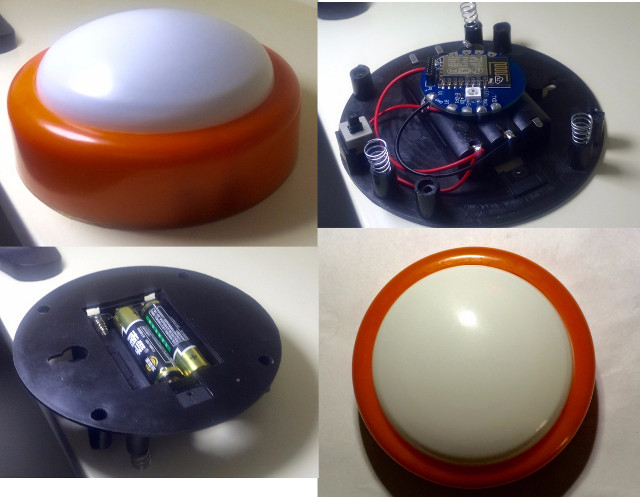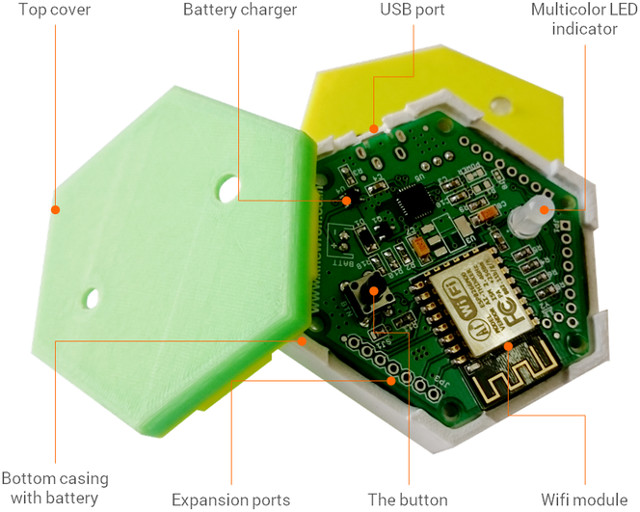If you have some WiFi power switch like Sonoff TH16 at home, you’d normally control them using a mobile app or a web interface. This is all good, but getting your phone, unlocking it, and launching the app to turn on or off an appliance is not the most efficient way to operate, and in some cases, some people in the household may not know how to use a smartphone. Physical WiFi buttons are the solution, but there aren’t so many for sale. We’ve seen previously it was possible to hack an Amazon Dash, but it’s not really that flexible, and 1btn could potentially be a better option, as it’s open source and based on Espressif ESP8266 WiSoC.
- WiFi Module – ESP-12F based on Espressif ESP8266
- MCU – Microchip Atmel ATmegaxx8 AVR MCU
- Connectivity – 802.11 b/g/b WiFi up to ~50 meter range
- USB – 1x USB port for charging and programming (via on-board USB to Serial chip)
- Misc – User button, multi-color LED, power on/off switch
- Expansion –
- AVR MCU – 2x 8-pin headers with ADC, I2C, SPI, RESET, 3.3V, and GND signals
- ESP8266 – 1x 8-pin header with GPIO, Tx/Rx signals, 3.3V and GND signals
- Battery – Rechargeable 3.7V/500mAh battery
- Dimensions – Around 60 mm side to side
- Weight – ~50 grams
The hardware design files, mechanical design, and NodeMCU (Lua) based firmware can all be found on Github, releases under an MIT license. The button can be used to send an email, text message (via Twilio SMS), or a tweet, as well as invoke an URL action allowing to use all sort of APIs and services such as IFTTT.
The Atmel MCU is used to keep battery life under check, as the button will only connect to WiFi then you press the button. It takes about 5 to 7 seconds to wake up from sleep, and send the message, after which the button goes back to sleep. The battery will last around 300 presses before it needs to be recharged, or about 5 months if you use the button twice a day.
1btn sells on Tindie for $40 plus shipping. That’s a little more than expected, so tried to look for alternative beside Amazon Dash, and I found “ESP8266 IFTTT WiFI Button Dev Kit” – aka Abutton – on Aliexpress going for $13.43 shipped. The button can be re-programmed with custom firmware, and is based on Apixel ESP8266 dev board with an ESP8266, but no MCU, so it has to rely on ESP8266 low power mode, meaning battery life is likely to be quite lower than 1btn. Talking about batteries, there are none, and instead there’s a compartment for 2 AA batteries. The Arduino or NodeMCU source code for Abutton can also be found on Github.

WiFi is not exactly the ideal wireless solution for this, that’s why Bluetooth buttons are much more common, and quite cheaper, so maybe having a ESP32 wireless power switch with WiFi and Bluetooth, plus a BT button would be both a better and cheaper solution. The only problem is that AFAIK ESP32 wireless switches don’t exist right now, except in board form factor, and not in a neatly packaged product like the Sonoff switch.

Jean-Luc started CNX Software in 2010 as a part-time endeavor, before quitting his job as a software engineering manager, and starting to write daily news, and reviews full time later in 2011.
Support CNX Software! Donate via cryptocurrencies, become a Patron on Patreon, or purchase goods on Amazon or Aliexpress





